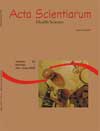<b>Strains selection methodology for cyclodextrin glycosyltransferase production and enzyme purification</b> - DOI: 10.4025/actascihealthsci.v29i1.133
Abstract
Cyclodextrins (CDs) are maltooligosaccharides produced from starch by cyclodextrin glycosyltransferase (CGTase) enzyme. This research aimed at establishing method for strains selection for CGTase production and enzyme purification. The microorganisms were selected from 53 analyses of starch cultures soils on plates containing specific culture medium for strains selection that produce CGTase. The enzymes were obtained by culturing these microorganisms in liquid medium. The enzyme activity was determined with photospectrometric methods and precipitation with trichloroethylene. The strain isolated from oat soil was the one that showed the highest activity [0.1864 µmol of ß-CD (min mL)-1]. This strain was used for enzyme production in laboratory scale and purification by biospecific affinity chromatography. The strain selected in this research opens new perspectives for enzymes production and CDs in industrial scale.Downloads
Download data is not yet available.
Published
2007-12-18
How to Cite
Costa, G. de L., Pazzetto, R., Brol, F., & Matioli, G. (2007). <b>Strains selection methodology for cyclodextrin glycosyltransferase production and enzyme purification</b> - DOI: 10.4025/actascihealthsci.v29i1.133. Acta Scientiarum. Health Sciences, 29(1), 45-50. https://doi.org/10.4025/actascihealthsci.v29i1.133
Issue
Section
Pharmacy
DECLARATION OF ORIGINALITY AND COPYRIGHTS
I Declare that current article is original and has not been submitted for publication, in part or in whole, to any other national or international journal.
The copyrights belong exclusively to the authors. Published content is licensed under Creative Commons Attribution 4.0 (CC BY 4.0) guidelines, which allows sharing (copy and distribution of the material in any medium or format) and adaptation (remix, transform, and build upon the material) for any purpose, even commercially, under the terms of attribution.
Read this link for further information on how to use CC BY 4.0 properly.























5.png)







